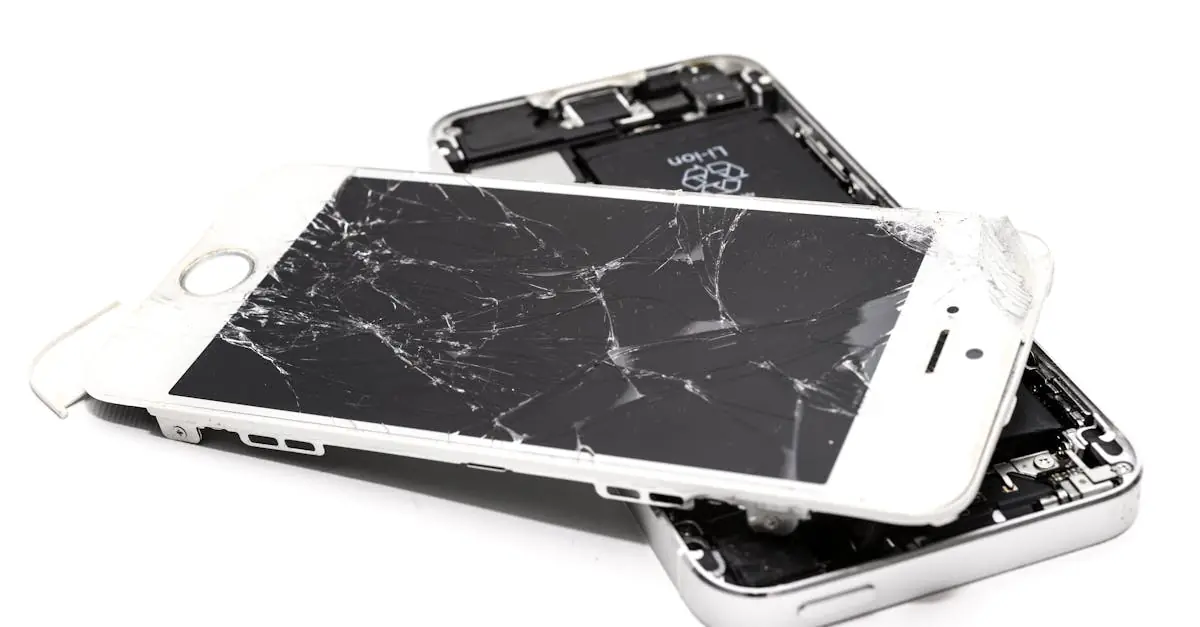Picture this: you’re scrolling through your favorite memes when suddenly—bam! Your iPhone screen goes black, leaving you staring at a lifeless slab of glass. Panic sets in, but don’t reach for the nearest brick just yet. A blacked-out screen can feel like the end of the world, but it’s often a fixable issue.
Table of Contents
ToggleUnderstanding Blacked Out iPhone Screens
A blacked-out screen can occur suddenly, leading to confusion and frustration. Understanding the underlying reasons can facilitate troubleshooting.
Common Causes
Several factors contribute to a blacked-out iPhone screen. Software glitches frequently lead to unresponsive displays, particularly after updates. Hardware damage from drops or water exposure can also result in screen blackouts. Inadequate battery life can cause the screen to turn off unexpectedly. Users’ settings, such as screen timeout duration or brightness levels, may unintentionally affect visibility. Faulty charging cables may prevent adequate power supply, further complicating the situation.
Signs of a Blacked Out Screen
Recognizing signs helps diagnose a blacked-out screen. First, an unresponsive display indicates the phone isn’t activating properly. Second, sound notifications, like incoming calls or texts, may still function, confirming the device powers on despite the black screen. Other signs include the inability to see the home screen or app icons. Users may notice that the device vibrates or heats up without displaying any visuals. Finally, if the device’s Siri feature responds but the screen remains dark, this further confirms the blackout issue.
Initial Troubleshooting Steps
Start by performing some basic troubleshooting steps when encountering a blacked-out iPhone screen. These actions often lead to quick resolutions for common issues.
Force Restart Your iPhone
A force restart might resolve many screen issues. Press and hold the Side button and either Volume button until the power off slider appears. Slide to turn off the device, then press and hold the Side button again until the Apple logo appears. This action resets the phone’s memory, which can clear temporary glitches causing the screen to blackout.
Check for Hardware Issues
Next, inspect hardware components for potential damage. Look for cracks, dents, or water damage on the exterior. Use a charging port brush to remove debris that can obstruct connections. Examine the charging cable for frays and test with a different charger if necessary. If the phone shows signs of impact or liquid exposure, consider seeking professional repair services to address issues.
Software Solutions
Software solutions can effectively address a blacked-out iPhone screen. Various methods exist to troubleshoot the issue, ensuring users regain functionality.
Update iOS
Updating iOS often resolves glitches that lead to display issues. Navigate to Settings, then General, and select Software Update to check for the latest version. If an update is available, download and install it. Keeping the software current ensures the device functions optimally and enhances overall performance. Regular updates can fix bugs and improve stability, helping to prevent blackouts from occurring in the future.
Reset All Settings
Resetting all settings can restore a device to its original state without erasing data. Go to Settings, tap General, then select Transfer or Reset iPhone, and choose Reset. The option labeled Reset All Settings allows for this action. After confirming, various settings, including display options and Wi-Fi passwords revert to factory defaults. While data remains intact, preferences set by the user change back to their defaults, potentially resolving the black screen issue by eliminating misconfigurations.
Advanced Fixes
Advanced troubleshooting can further resolve a blacked-out iPhone screen. These methods include restoring using iTunes and employing recovery mode.
Restore Using iTunes
Restoring via iTunes often resolves deeper software issues causing the black screen. First, connect the iPhone to a computer with iTunes installed. Next, select the device when it appears in iTunes. Afterward, choose the “Restore” option, which will erase all data and install the latest iOS version. Ensure a backup exists beforehand to prevent data loss. Completing this process might take several minutes, so patience is necessary.
Use Recovery Mode
Using recovery mode provides another layer of troubleshooting for a non-responsive iPhone screen. To activate recovery mode, first, connect the device to a computer and open iTunes. Then, press the Side button and the Volume down button simultaneously until the recovery mode screen appears. A prompt will then show options to update or restore. Choosing “Update” may reinstall iOS without erasing data. If unsuccessful, selecting “Restore” may be required. Recovery mode allows for troubleshooting more profound software issues that standard methods may not address.
A blacked-out iPhone screen can be alarming but it’s often a solvable issue. By understanding the potential causes and following the outlined troubleshooting steps users can restore their device to normal functionality. Whether it’s a simple force restart or more advanced solutions like restoring through iTunes the key is to remain calm and methodical.
Regular updates and proper care can also prevent future occurrences. If the problem persists despite attempts to fix it seeking professional assistance is advisable. With the right approach most users can overcome this frustrating situation and enjoy their iPhones once again.



